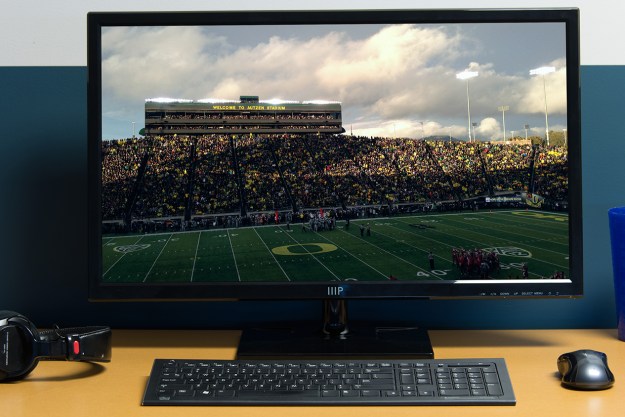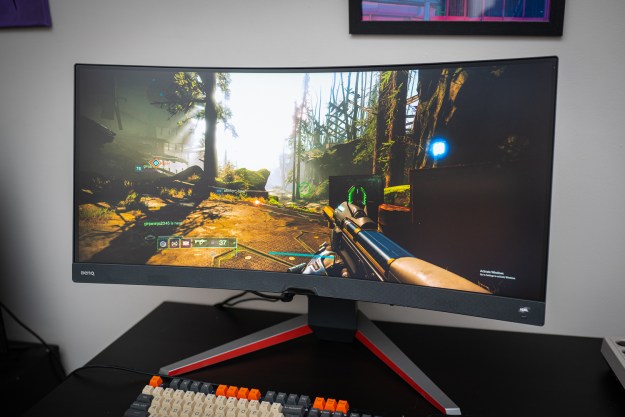
“Hit Monoprice for your cables, but steer clear from its cut-rate monitors.”
- Intuitive on-screen controls
- Diverse inputs
- Respectable contrast and color accuracy
- Wobbly stand
- Weak speakers
- Limited color gamut
- Not a good value
You’ve probably heard of Monoprice before. It’s become famous among geeks as the place to buy cables and cords, from HDMI to Ethernet. The concept is simple. Monoprice sells off-brand equipment straight to you, cutting out all the needless marketing. That means anyone can nab fifteen feet of HDMI for six bucks. Swing by your local Best Buy and you’ll be spending $20, at least.
Monoprice applies the same strategy elsewhere, including computer monitors. As different as that may seem from a cable, the idea is the same. Most monitors use a panel from small handful of manufacturers, which is packaged and sold under one of many brands. So why pay for the marketing? Why not just buy the panel direct?
The awkwardly named 28-inch UHD Select Series Matte 4K 60Hz is the answer to that question. On paper, it can go toe-to-toe with any other 4K display on the market. It provides 3,840 x 2,160 resolution, a TN-panel with a five millisecond gray-to-gray response time, and a 60Hz refresh rate. It even has built-in speakers.
But the most important specification is the price. At $400, the UHD Select Series undercuts almost everything on the market. Acer impressively does offer a 4K monitor for less, but there’s nothing else from a major brand that comes close. Is Monoprice’s screen as sensible as a six dollar HDMI cable, or should you spend more?
Wobble trouble
Though sold by Monoprice, the UHD Select Series isn’t built by Monoprice, and isn’t branded with the company’s name. Instead the monitor has a label on it that reads “IIIP” and stands for – something. Who cares? It could stand for Interplanetary Infrared Induction Panel, for all it matters.
Editor’s note: Embarrassingly, Monoprice has pointed out the “IIIP” actually stands for “Monoprice,” and this is supposed to be a Monoprice branded product. I’m not sure the logo is intuitive, but in hindsight, I should’ve caught that.
What does matter is material the panel is cased in, and as the price suggests, it’s not great. Cheap, glossy black plastic is the order of the day. It does the job of keeping the screen from tumbling onto the floor, and that’s it.
The stand, also built of glossy black plastic, is similar, but its flaws are more meaningful. The cheap construction means tilt is the only adjustment available, and the thin neck supporting the monitor allows plenty of wobble. Like an old car with blown shocks, even the slightest movement can make the monitor do a great impression of Jell-O.
Fortunately, a VESA mount is included, so you can bring your own stand. Given the stand’s weakness, and lack of adjustments, I recommend it as a mandatory upgrade.
There’s an input for that
The UHD Select Series covers its bases with connectivity, offering DisplayPort 1.2, HDMI 2.0, Dual-Link DVI, and VGA, along with a line-in for separate audio input. That’s an excellent array that bests most budget monitors.
So many options
Firing up the monitor’s on-screen control panel is easy. Like most, it uses several buttons, which are used to select through the menu. Each button is clearly labeled, so there’s little confusion about what it does.
The cheap stand jiggles like a car with blown shocks.
There’s also a plethora of extra, poorly documented features, ranging from noise reduction to super resolution, most of which aren’t useful. Some users may appreciate the picture-in-picture and picture-by-picture functions.
Listen up
A pair of two-watt speakers are included. They produce sound, but that’s about the only positive thing I can say about them. They’re not even oriented towards the viewer, so most of their meager volume is lost if the monitor is pushed up against a wall.
Pre-calibration quality
I set up the UHD Select Series after using the excellent Acer S277HK for several months, and the off-brand competitor didn’t fare well out of the box. The default color quality is way too cool, giving content a sterile, clinical look. That’s a common problem for any LED backlit monitor, but it was particularly bad in this instance. Colors looked drab and lifeless, especially in landscape scenes that prioritized greens (like a forest) or reds (such as a desert) over clear blue skies.
The calibration report showed the problem was primarily the color gamut, which reaches only 94 percent of sRGB and 70 percent of AdobeRGB. Those aren’t terrible figures, but they’re the worst we’ve yet recorded from a 4K display.
There were some perks to the monitor’s performance, however. It managed a respectable contrast ratio of 640:1, an average color error of 2.88, and hit the ideal gamma performance of 2.2. While it’s no class-leader in these more technical aspects, it’s on par with more expensive alternatives.
Post-calibration quality
I fired up our calibration utility to see if more could be squeezed out of the display. That answer was yes – but not enough to make the UHD Select Series a performance stand-out.
While the monitor comes through in gamma, it stumbles in color gamut.
While the numbers seem to have barely changed, they made a big difference in visual quality. The extremely cool look of the stock picture was partially tamed, allowing other colors to come to the fore. That helped to create a more vivid and lifelike picture. Color temperature was still too cool, though. It was most noticeable in bright, white screens, which were obviously tinged blue rather than pure white.
Conclusion
The DT Accessory Pack
EVGA GeForce GTX 980Ti ($660)
If you want to game on this Monoprice 4K monitor, you’ll need a serious video card – like Nvidia’s GTX 980 Ti.
VIVO single LCD monitor stand ($40)
This inexpensive VESA compatible stand can provide the Select Series with much-needed stability.
Datacolor Syder5Pro ($140)
The Spyder5Pro is a great, reasonably affordable way to calibrate your monitor for maximum color accuracy and contrast.
Monoprice’s UHD Select Series offers an attractive proposition. It serves up 4K resolution, and plenty of ports, for just $400. That’s tempting.
But you don’t get what you didn’t pay for. The monitor performed well in certain areas, such as gamma and contrast, but it came in behind the curve in color gamut. The result? Picture quality that’s not in the same league as many competitors.
4K for $400 could be appealing if the alternatives were expensive, but they’re not. The CTL X2800, which is better in most respects, is also $400. The far superior Acer S277HK, which embarrasses the Select Series, is $150 more. Most stunning is the Dell P2715Q, an astoundingly good set, which is now sold for as little as $520.
This Monoprice seems built for a world where 4K is inaccessible, but this isn’t 2014. While still a bit costly,
Available from: Amazon | MonoPrice |
Highs
- Intuitive on-screen controls
- Diverse inputs
- Respectable contrast and color accuracy
Lows
- Wobbly stand
- Weak speakers
- Limited color gamut
- Not a good value
Editors' Recommendations
- Best Samsung monitor deals: 4K monitors, ultrawide, and more
- The best GPUs for 4K to make your games look awesome
- HP takes on Alienware and Samsung with its 4K QD-OLED gaming monitor
- We’re finally getting a 4K OLED gaming monitor, and it’s coming soon
- The best 4K laptops for 2023





